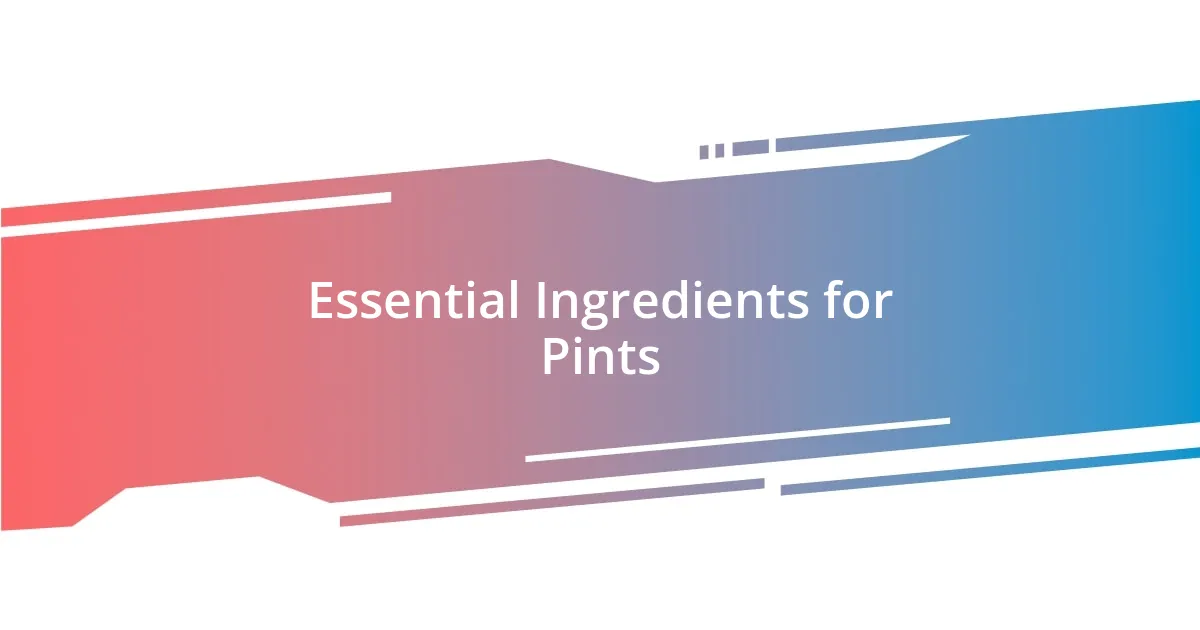Key takeaways:
- The glass shape significantly influences the perception of flavors and aromas in beer.
- Key ingredients like hops, malt, yeast, and water each play crucial roles in creating a balanced and flavorful pint.
- Foam stability enhances the drinking experience by trapping aromas and improving mouthfeel.
- Serving temperature is vital for preserving the beer’s intended flavors, with different styles requiring specific ranges.

Understanding Perfect Pints
When I think about what makes a pint perfect, I dive into the harmony of flavors, aromas, and textures. It’s fascinating how the right balance can elevate the entire experience. Have you ever taken a sip and felt a rush of nostalgia, feeling transported to a sunny afternoon at your favorite pub? Those moments are what I cherish.
For me, the glass plays a surprisingly crucial role in this perfection. I remember the first time I sipped a rich stout from a tulip glass—it unleashed the aromas in a way I had never experienced before. Suddenly, the beer transformed, revealing layers of dark chocolate and coffee that danced on my palate. Have you ever considered how the shape of your glass can impact your tasting journey?
Temperature is another pivotal factor. I can’t help but recall a time when I hurriedly poured a lager from the fridge without letting it warm slightly—a mistake I won’t forget. The chilled temperature masked the nuanced flavors, leaving me disappointed. Have you found yourself in a similar situation? It’s those little details that truly shape our understanding of what a perfect pint should be.

Essential Ingredients for Pints
When I think about the essential ingredients for creating a perfect pint, hops immediately come to mind. They not only contribute bitterness but also impart unique floral and citrus notes that can define the entire flavor profile. I remember one night at a craft brewery, where I tried a pale ale bursting with grapefruit essence; it was an exhilarating taste experience that made me appreciate the hops’ role even more.
The choice of malt is equally important, as it adds body and sweetness, balancing the hop bitterness. I once crafted a homebrew using caramel malt, which lent a delightful toffee note that paired marvelously with the hops. It’s intriguing how the right combination can elevate a pint from good to extraordinary, don’t you think? And let’s not forget the yeast, the unsung hero that ferments sugars into alcohol and influences flavor. I once had a Belgian tripel that showcased the yeast’s character beautifully, revealing fruity esters that lingered on the palate.
Finally, water might seem like a simple element, but I’ve learned that its mineral content can dramatically affect the final brew. On one occasion, I used distilled water for a stout I was brewing, and the result lacked the deep richness that I expected. This experience taught me to pay closer attention to the base water’s profile, leading me to discover how crucial it is to achieving that ideal pint experience.
| Ingredient | Role |
|---|---|
| Hops | Adds bitterness, flavor, and aroma |
| Malt | Contributes sweetness and body |
| Yeast | Ferments sugars; influences flavor |
| Water | Affects texture and overall taste |

Techniques for Achieving Foam
Achieving the perfect foam on a pint is an art that balances technique and science. One of the first steps I learned involves the pouring angle. Instead of a straight pour, I find that tilting the glass to about a 45-degree angle allows for a gentle introduction of the liquid, creating a smooth pour that helps form a robust head. There’s just something satisfying about watching that foam rise as it settles.
Here are some additional techniques that help enhance that beautiful foam:
- Chill the Glass: A cold glass can initially help retain a thicker foam. Just remember not to over-chill, as it can inhibit flavors.
- Mind the Pouring Technique: Start pouring with the glass tilted, then upright midway to ensure proper CO2 release.
- Use Fresh, Quality Ingredients: Fresh hops and malt contribute to better stability and integrity of foam.
- Cleanliness Matters: Residue or oils from previous drinks can disrupt foam formation; make sure your glass is spotless.
- Control Carbonation Levels: Over-carbonation can create an excessive head, while under-carbonation may result in a disappointing flatness.
In my experience, mastering the foam can transform the appearance and mouthfeel of a pint, making it visually inviting and deliciously satisfying. I recall a beer tasting event where the host shared the importance of foam stability. After hearing about how it can lock in the aromas, I paid closer attention to my pours. Seeing my friends rave about the creamy foam atop their pints made me realize how vital this elegant layer is to our enjoyment.

Beer Pouring Methods Explained
I’ve come to realize that the method of pouring beer can dramatically change the entire drinking experience. For instance, the “quick pour” method involves pouring the beer straight into the glass, which creates a thick head of foam at the top. I remember one time at a local pub, I watched a bartender demonstrate this technique with a stout. The dense head was not just for show; it helped trap the aromas, enhancing each sip. Isn’t it fascinating how a simple change in technique can influence the overall perception of flavor?
Another method worth mentioning is the “gentle pour,” which you can achieve by pouring down the side of the glass. This technique is especially handy for more carbonated styles, as it minimizes excessive foam. I had an enlightening experience when a friend and I compared the taste of a lager poured this way versus a quick pour. The gentler approach allowed us to savor the subtle notes of the beer more intensely. How do you usually pour your beers, and have you considered trying different techniques?
Then there’s the “layered pour,” often used for beers with different densities, like a Black and Tan. This pouring method requires careful attention—a slow pour of the lighter beer first and then the dark beer, allowing them to layer beautifully. Once, I attempted this at home, and I felt like a true craftsperson as I crafted a visually stunning pint. It reminded me that pouring beer is not just about filling a glass; it’s about the story and experience that unfolds with each layer. What stories do your pouring methods tell?

Choosing the Right Glassware
When it comes to choosing the right glassware, I believe it’s a game changer. Different styles of beer truly shine in specific types of glasses. For instance, I used to pour my IPA into any glass I grabbed, but once I tried a tulip-shaped glass, I noticed how it captured the hop aromas so much better. Have you ever experienced that moment when the right glass makes all the difference?
I also fondly remember my first time using a snifter for a rich stout. Holding that curved glass in my hands, I felt the warmth of the beer radiate, and each sip became an immersive journey through its complex flavors. It’s incredible how the right glass can enhance not just the taste, but also the entire sensory experience of drinking. What’s your favorite glass to sip from, and how does it change your enjoyment?
Then there are the functional aspects to consider. A good pint glass should feel comfortable to hold, and I’ve found that heavy glasses often add a touch of elegance to the experience. I once hosted a gathering where I served a variety of beers, each in its own distinct glass. The reactions from my friends were priceless as they appreciated not only the flavors but also how the glassware elevated the atmosphere. What impact does the weight and feel of a glass have on your drinking experience?

Temperature Control for Pints
When it comes to temperature control, I can’t stress enough how crucial it is for achieving the perfect pint. I remember a time when I served an IPA that was too warm, and I felt disappointed by how the hops lost their vibrant character. It was then I learned that the ideal serving temperature for most IPAs is around 45-50°F (7-10°C). Have you ever tasted a beer that was served at the wrong temperature? It can truly ruin the experience.
I’ve also experimented with chilling my glasses before pouring. A simple trick, yet an effective one! I recall a warm summer evening where I poured a lager into a chilled glass; the crispness was amplified. The light and refreshing profile shone through beautifully and made each sip downright refreshing. How often do you find yourself ignoring this step? It can transform your drinking pleasure.
One thing I’ve come to appreciate is how different styles of beer have their own temperature preferences, affecting flavor and aroma. For example, stouts are best served slightly warmer at about 50-55°F (10-13°C) to reveal their rich complexity. I vividly remember savoring a stout on a cozy winter night, allowing its warmth and flavors to unfold. It’s amazing how temperature can tell a story, isn’t it?















